The Apple iPad Pro Review
by Ryan Smith, Joshua Ho & Brandon Chester on January 22, 2016 8:10 AM ESTSystem Performance Cont'd
Continuing on with our more game-like benchmarks, tests like 3DMark and GFXBench are supposed to replicate gaming workloads to help determine relative performance in most common 3D games. In the case of the iPad Pro, the GPU is a 12 cluster variant of the PowerVR Series7XT GPU architecture. This is double the number of clusters relative to the A9’s GPU, which should prove to be quite impressive judging by the GPU performance that we saw in the iPhone 6s.
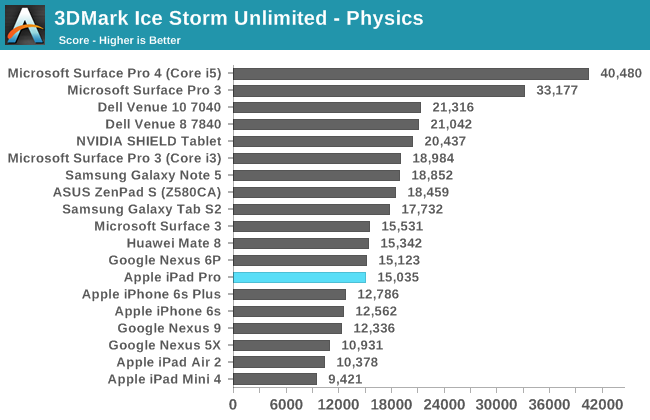
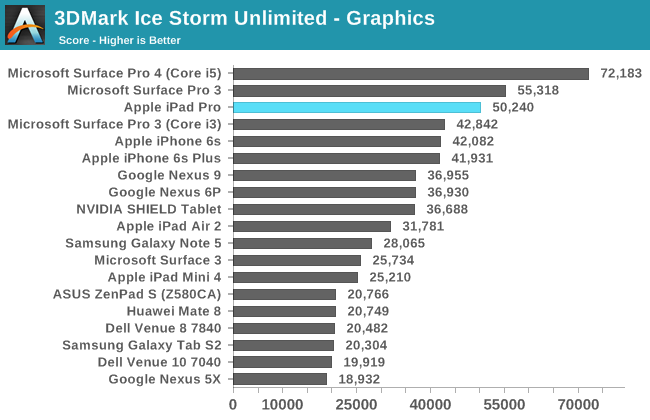
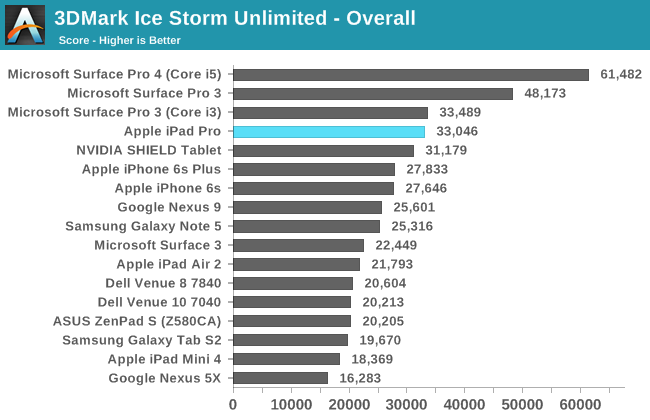
The iPad Pro manages to maintain superiority in 3DMark, but we're really starting to see the limitations of this test. The physics test generates non-sequential data structures with memory dependencies, which can penalize devices with lower core count and clock speed, but the workload is able to be spread across multiple cores to exploit TLP, which benefits devices with more real cores, or virtual ones (hyperthreading). We also see that the graphics test isn't really scaling well at this point as it's just too light to take advantage of the full potential of the A9X GPU. This likely also explains why the iPad Pro isn't closer to the Surface Pro 4 in performance on this benchmark, given what we know about A9X's GPU.
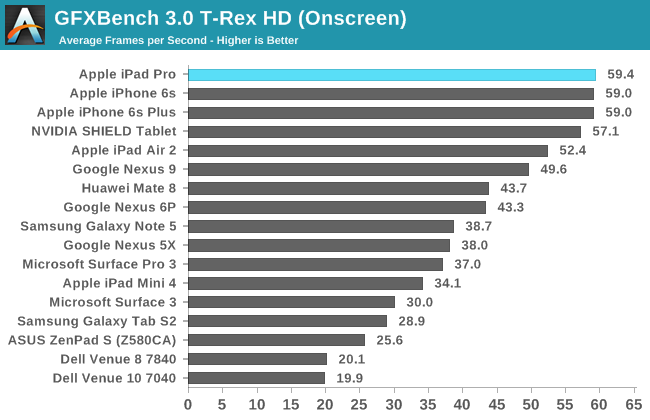
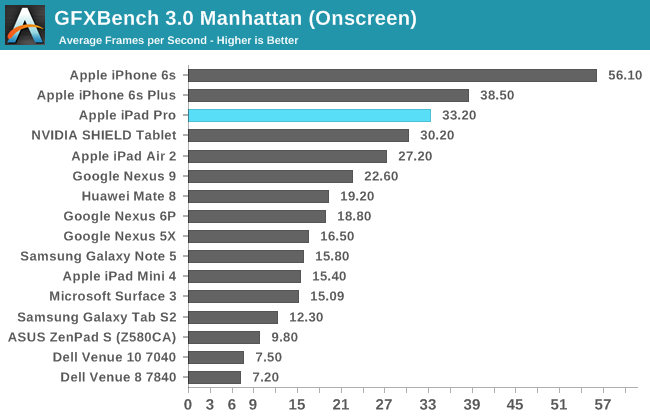

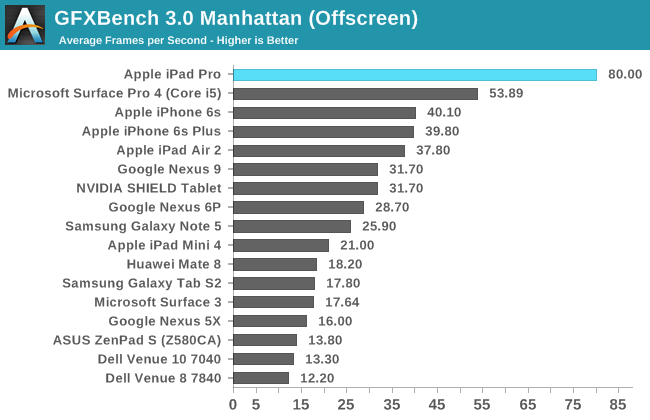
In GFXBench we can see the major benefits that really come with the larger GPU. It's pretty obvious here that clock speeds are basically identical when comparing the A9 GPU and A9X GPU as the scaling is almost perfectly double. In this benchmark the iPad Pro quite handily beats the Surface Pro 4, but it's important to keep in mind that the Surface Pro 4 is running a higher level of precision and that the iPad Pro is running OpenGL ES rather than OpenGL in this test, so it isn't strictly apples-to-apples (nor is such a thing truly possible at this time). Overall though the GPU of the iPad Pro is incredibly impressive, and I doubt that anyone will really have issues with gaming performance on this device.
NAND Performance
At this point it’s pretty well understood that storage performance can often be a gating factor in performance. Although caching is an amazingly effective method of hiding memory latency, for the first hit it’s mandatory to miss the cache unless you’ve managed to prefetch the data in question. The other issue where storage performance becomes obvious are cases where it’s necessary to commit data to storage first. Some cases where this is going to be obvious is app installation or iCloud restores, especially when network performance is at the point where installation can actually be gated by writing to disk rather than downloading from the network.
In the case of the iPad Pro, Apple claims that they’ve implemented a storage controller comparable to some desktop SSDs. It turns out that this controller is a familiar one, as the storage controller identifies itself as the APPLE SSD AP0128K in the case of this review unit. It turns out that everything about this SSD is identical to what we saw in the iPhone 6s as well, down the use of Hynix for at least one of the NAND vendors and the hybrid SLC/TLC architecture discussed in previous articles. In order to test how this storage solution performs we once again use Eric Patno’s StorageBench, which provides a rough analogue to AndroBench 3.6.
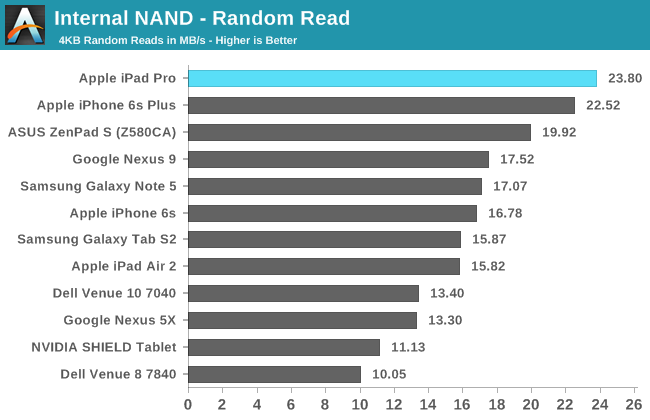

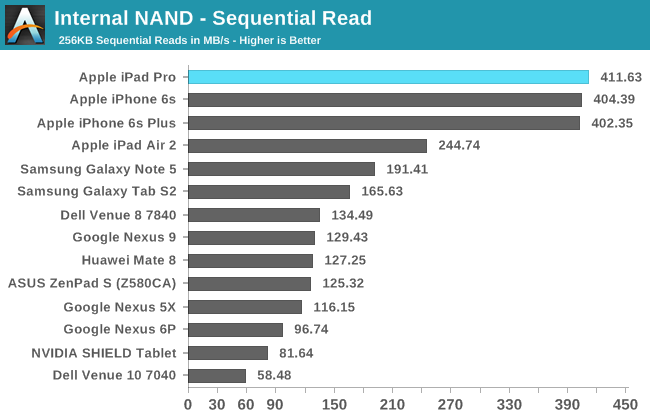
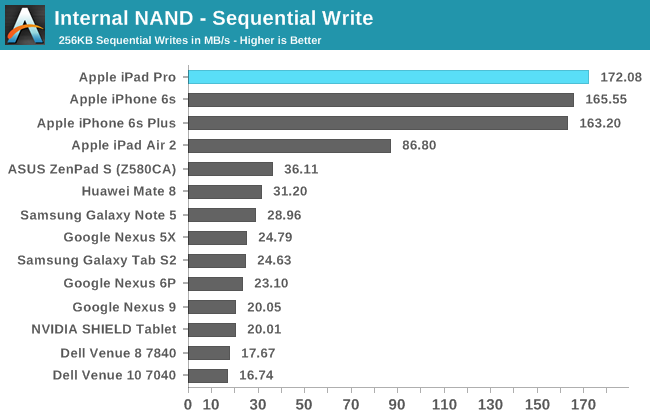
It turns out that in this test, performance is basically identical to the iPhone 6s. This isn’t quite the equal of something like the Surface Pro 4’s PM951 SSD, which has the advantage of more NAND dies working in parallel, but given that the iPad Pro PCB size isn’t going to be anywhere near that of the Surface Pro 4 it’s likely that this is a concession to gain better battery life. I definitely wonder what performance would be like relative to a Surface Pro 4 if the iPad Pro had a 512GB SKU, but given that the iPad Pro tops out at 128GB this isn’t really a question with a relevant answer.










408 Comments
View All Comments
ddriver - Sunday, January 24, 2016 - link
Bing is a professional application for every professional lamer. To the latter, the ipad "pro" is a professional product too.ddriver - Sunday, January 24, 2016 - link
LOL At most 2 or 3 of those could qualify for "professional" if one is inclined to be generous with the labels.Professional applications - photoshop, 3d max, maya, solidworks, coreldraw, indesign, visual studio, cubase, pro tools, after effects, fusion, z-brush, and so on.
10101010 - Friday, January 22, 2016 - link
Yeah, I'm sure that's why the combined "hammer + screwdriver" tool market is just booming.ddriver - Friday, January 22, 2016 - link
Yeah, I am sure making good analogies is not your strong point.A more appropriate analogy would be those screwdriver kits with a single handle and interchangeable tips, saving you the effort to carry around 20 different screwdrivers, and those kits are GREAT ;)
But we aren't talking just any hardware here, we are talking computers, and general purpose at that, this is not the case of some special purpose hardware. This is a general purpose computer, and what it does is defined entirely by its software. Absent any software, it is just a paper weight, or a serving tray, absent professional software it is just a toy, intended to milk people out of their money.
lmcd - Tuesday, February 9, 2016 - link
I mean, a lot of the times they are bought in bundles ;)abazigal - Friday, January 22, 2016 - link
Possibly because there isn't a hybrid that is as good as a dedicated laptop and a dedicated tablet. You are essentially trading one set of compromises for another, and people's mileage will vary.ddriver - Friday, January 22, 2016 - link
So a "hybrid" being 10% heavier and 10% thicker than a tablet, and 10% slower than a laptop justifies buying and carrying a tablet and a laptop instead of a hybrid?Obviously, a hybrid will be a little slower than a laptop and a little heavier than a tablet, but in many cases that is not detrimental. People should have the option to use their devices to the full extent of their capabilities, and whoever needs the extra horsepower will buy a laptop or even a desktop system instead.
I really don't understand how come people have such a big problem with maximizing a device capability and productivity? IN what way will the availability of professional software for iOS hurt you?
10101010 - Saturday, January 23, 2016 - link
I just don't see a "hybrid" being defined primarily by size, weight, or speed. If we look at a hybrid such as the "Surface Pro", it is defined mostly by its Windows 10 operating system. This is an insecure loaded-with-spyware-at-the-factory desktop OS that pretends to be a tablet OS, laptop OS, server OS, phone OS, etc. There are really no great Windows apps made specifically for a tablet (although a few work nicely with a pen/stylus). So at the end of the day what is a Surface Pro "hybrid" really? It is a desktop OS and a keyboardless laptop. It's marketed as "best of both" but really it is a Frankenstein computer made of parts that Microsoft sawed off other products.Contrast Microsoft's Frankenstein with the iPad Pro -- a tablet built to be a tablet that runs what is widely regarded as the most stable, secure, and highest quality mobile OS. And delivers the closest thing yet to "paper and pencil" functionality to the market. Your point about the professional software is right on. As the apps evolve for the iPad Pro and more professional apps become available, it will only expand what an iPad Pro can be used for, opening the tablet up to being useful for more customers.
ddriver - Saturday, January 23, 2016 - link
I am sure iOS is spying on users as much as Windows 10, after all, M$ was largely inspired by Apple in this regard. And unlike W10, you can't really disable it in iOS.Unfortunately, the lack of professional applications, whose UI is usable on a tablet is true, be those windows, android or ios tablets. I do acknowledge that the only reason windows tablets have the upper hand is they can run the good old legacy professional software, which is a pain in the ass to use without a mouse and keyboard.
It would seem that the industry is rather unimaginative, they keep releasing new versions of their professional products, but don't adopt a better paradigm for user interaction, one that would work equally well on a traditional desktop PC and a tablet. Software giants are just as lazy and unimaginative as hardware giants.
And it is not like it is impossible, it is well within the realm of possibility to adapt the UI for wider device usage without impairing productivity, if anything, a more clever design will make application interaction easier, a lot of the professional app UIs are a pain to work with, even with a mouse, and practically impossible to use with a touch device.
One of the projects I am currently working on is a graphical programming language / IDE, capable of producing commercial grade software, and it is equally useful on a desktop with mouse and keyboard and on a tablet or even on a phone with touch. It is 2-3 months away from public release, unfortunately due to apple's policies, I will not be publishing to their store, since they don't really allow the degree of freedom an application development tool requires. It will still be available for jail broken apple hardware.
Constructor - Saturday, January 23, 2016 - link
I am sure iOS is spying on users as much as Windows 10, after all, M$ was largely inspired by Apple in this regard. And unlike W10, you can't really disable it in iOS.That is just nonsense. Apple is very careful about looking at user data, and in fact they credibly follow the tenet "the less of your information we look at, the better!".
That is not how Microsoft is proceeding with Windows 10 – there they seem to go more the Google route.